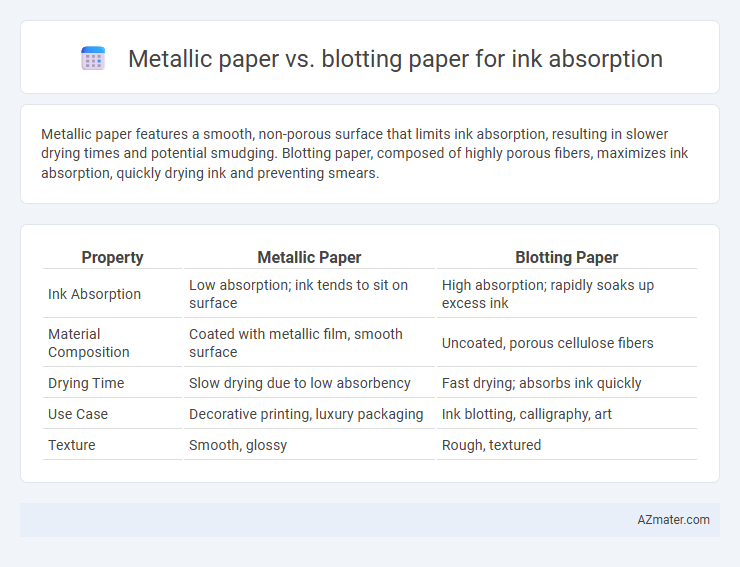Metallic paper features a smooth, non-porous surface that limits ink absorption, resulting in slower drying times and potential smudging. Blotting paper, composed of highly porous fibers, maximizes ink absorption, quickly drying ink and preventing smears.
Table of Comparison
| Property | Metallic Paper | Blotting Paper |
|---|---|---|
| Ink Absorption | Low absorption; ink tends to sit on surface | High absorption; rapidly soaks up excess ink |
| Material Composition | Coated with metallic film, smooth surface | Uncoated, porous cellulose fibers |
| Drying Time | Slow drying due to low absorbency | Fast drying; absorbs ink quickly |
| Use Case | Decorative printing, luxury packaging | Ink blotting, calligraphy, art |
| Texture | Smooth, glossy | Rough, textured |
Introduction to Ink Absorption Materials
Metallic paper and blotting paper serve distinct roles in ink absorption due to their differing compositions and textures. Metallic paper, coated with a smooth, reflective surface, offers limited ink absorption, making it ideal for vibrant print applications but less suitable for rapid ink drying. Blotting paper, composed of highly porous fibers, excels at quickly absorbing excess ink, preventing smudging and ensuring clean, crisp writing or artwork.
What is Metallic Paper?
Metallic paper is a specialized printing material coated with a reflective metal film, commonly aluminum, providing a glossy and shiny surface ideal for high-quality image reproduction. Unlike blotting paper, which is highly porous and designed to absorb excess ink quickly to prevent smudging, metallic paper offers minimal ink absorption, causing ink to sit on the surface and enhance color vibrancy and sharpness. This makes metallic paper suitable for vivid prints but less effective for applications where ink absorption and drying speed are critical.
What is Blotting Paper?
Blotting paper is a highly absorbent material used to quickly soak up excess ink from paper surfaces, preventing smudging and promoting faster drying. Unlike metallic paper, which has a smooth, non-absorbent surface designed for glossy prints, blotting paper features a porous structure ideal for ink absorption. This makes blotting paper essential in calligraphy, ink drawing, and situations where precision ink control is required.
Structure and Composition Differences
Metallic paper features a smooth, coated surface primarily composed of synthetic materials and a thin metal layer, which reduces its ink absorption capacity by preventing rapid ink penetration. Blotting paper consists of highly porous, fibrous cellulose structure specifically designed to absorb excess ink quickly through capillary action. The contrasting compositions directly influence their functions: metallic paper resists ink absorption for sharp prints, while blotting paper excels in soaking up ink to prevent smudging.
Mechanisms of Ink Absorption
Metallic paper resists ink absorption due to its non-porous, coated surface, causing ink to sit mainly on the top layer and dry slowly through evaporation. Blotting paper features a highly porous, fibrous structure that rapidly absorbs ink via capillary action, drawing liquid into its network and preventing smudging. The fundamental difference lies in metallic paper's surface tension dynamics versus blotting paper's deep absorption and dispersion capabilities.
Absorption Rate: Metallic vs Blotting Paper
Blotting paper exhibits a significantly higher absorption rate compared to metallic paper due to its porous and fibrous texture, which rapidly draws ink away from the surface. Metallic paper, coated with a non-porous metallic finish, restricts ink absorption, causing slower drying times and potential smudging. For applications requiring fast ink absorption and minimal smearing, blotting paper is the optimal choice over metallic paper.
Applications in Art and Printing
Metallic paper offers a reflective surface that resists ink absorption, making it ideal for high-impact graphic designs and decorative prints that emphasize sheen and vibrancy. Blotting paper features high absorbency, quickly soaking up excess ink to prevent smudging and promote clean, crisp lines, essential for calligraphy and traditional ink illustrations. Artists and printers select metallic paper for visual effects and blotting paper for precision and control in ink-based applications.
Durability and Sustainability Comparison
Metallic paper exhibits high durability due to its coated surface, which resists ink bleed but limits absorption, making it less suitable for blotting applications. Blotting paper excels in ink absorption with its porous cellulose fibers, promoting efficient drying while being biodegradable and environmentally sustainable. From a sustainability perspective, blotting paper offers an eco-friendly advantage over metallic paper, which involves more resource-intensive production and limited recyclability.
Cost and Availability Factors
Metallic paper, often used for decorative purposes, tends to be more expensive and less widely available compared to blotting paper, which is specifically manufactured for efficient ink absorption at a lower cost. Blotting paper, made from highly absorbent cellulose fibers, quickly soaks up excess ink, making it a practical choice in both professional and educational settings. The cost-effectiveness and widespread availability of blotting paper make it the preferred option when ink absorption is the primary concern.
Choosing the Right Paper for Your Needs
Metallic paper offers a glossy surface that repels ink, making it unsuitable for absorption but ideal for vibrant prints, whereas blotting paper excels in quickly absorbing excess ink to prevent smudging and facilitate drying, especially with fountain pens. When choosing the right paper for ink absorption, consider blotting paper for tasks requiring rapid drying and minimal bleeding, while metallic paper suits decorative or display purposes where ink smudging is less critical. Prioritize blotting paper for practical ink management and metallic paper for aesthetic presentation to match your specific writing or printing needs.

Infographic: Metallic paper vs Blotting paper for Ink absorption
 azmater.com
azmater.com